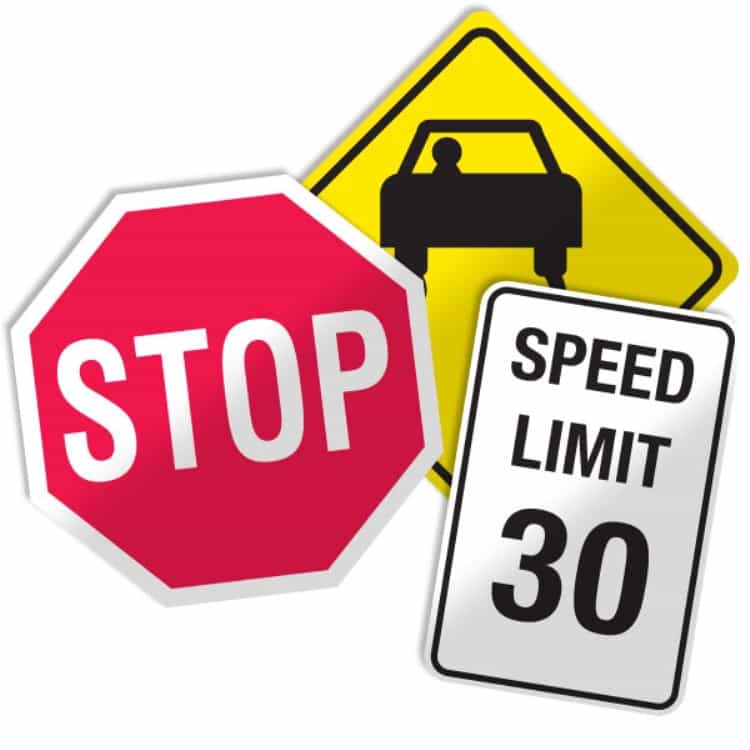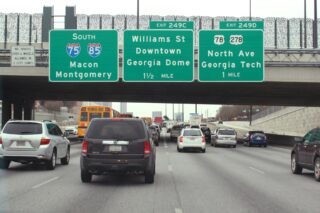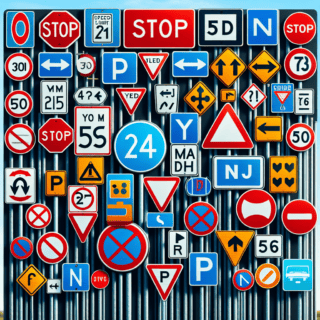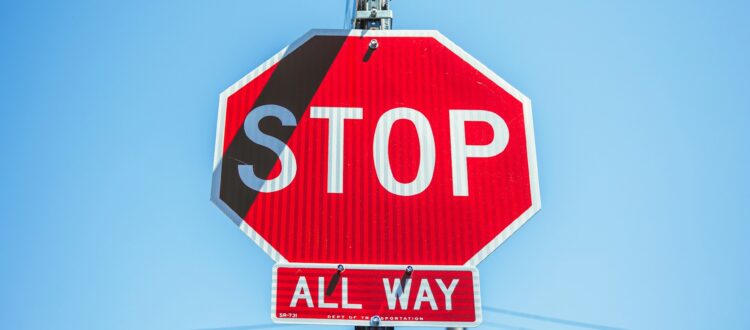The Manual on Uniform Traffic Control Devices (MUTCD) sets the standard for the design, application, and placement of traffic control devices, including highway signs, in the United States. These signs play a crucial role in guiding drivers, pedestrians, and cyclists by providing essential information about road conditions, directions, and potential hazards.
The MUTCD highway signs are designed to be easily recognizable, with standardized shapes, colors, and symbols to ensure consistency and clarity across the country’s roadways. From regulatory signs that convey speed limits and parking rules to warning signs that alert drivers to upcoming curves or intersections, these highway signs are an integral part of maintaining safety and efficiency on the road.
What are MUTCD Highway Signs?
 MUTCD highway signs, governed in the USA by the FHWA (Federal Highway Administration of the US Department of Transportation -a.k.a. USDOT), are vital elements of the transportation infrastructure in the United States. These signs serve as a standardized means of conveying essential information to road users, including drivers, pedestrians, and cyclists. These regulated standard highway signs encompass a wide range of categories, including regulatory signs that indicate speed limits, parking regulations, and other rules of the road.
MUTCD highway signs, governed in the USA by the FHWA (Federal Highway Administration of the US Department of Transportation -a.k.a. USDOT), are vital elements of the transportation infrastructure in the United States. These signs serve as a standardized means of conveying essential information to road users, including drivers, pedestrians, and cyclists. These regulated standard highway signs encompass a wide range of categories, including regulatory signs that indicate speed limits, parking regulations, and other rules of the road.
Furthermore, warning signs are employed to alert drivers to potential hazards such as sharp curves, intersections, or pedestrian crossings. Guide signs provide directional information, helping travelers navigate highways, exits, and points of interest. By adhering to strict design and placement standards, these highway signs ensure consistency and clarity across the nation’s road network, contributing to safer and more efficient transportation for all.
What is the Purpose of MUTCD on Highway Signs?
The purpose of the Manual on Uniform Traffic Control Devices (MUTCD) in relation to highway signs is to establish uniformity, consistency, and effectiveness in the design, application, and placement of traffic control devices on roadways throughout the United States. By providing standardized guidelines for the design and usage of highway signs, the MUTCD aims to enhance safety, facilitate efficient traffic flow, and ensure clear communication of essential information to all road users.
This includes drivers, pedestrians, and cyclists who rely on the information conveyed by highway signs to navigate the road network safely and effectively. The MUTCD serves as a crucial tool for transportation agencies and road authorities to maintain a cohesive and understandable system of highway signs, ultimately contributing to the overall safety and functionality of the nation’s roadways.
What are the Categories of MUTCD Highway Signs?
1. Regulatory Signs: These signs convey traffic laws and regulations that drivers must obey, such as speed limits, parking restrictions, and right-of-way rules. Regulatory signs are crucial for maintaining order and safety on roadways by informing drivers of legal requirements and restrictions.
2. Warning Signs: Warning signs are designed to alert drivers to potential hazards or changes in road conditions ahead, such as sharp curves, intersections, pedestrian crossings, and animal crossings. These signs provide advance notice to drivers, allowing them to adjust their speed and behavior accordingly to navigate potential dangers safely.
 3. Guide Signs: Guide signs provide essential information to road users, including directions to specific destinations, highway exits, services, and points of interest. These signs play a crucial role in helping drivers navigate unfamiliar areas, plan their routes, and make informed decisions while traveling on the road network.
3. Guide Signs: Guide signs provide essential information to road users, including directions to specific destinations, highway exits, services, and points of interest. These signs play a crucial role in helping drivers navigate unfamiliar areas, plan their routes, and make informed decisions while traveling on the road network.
4. Temporary Traffic Control Signs: These signs are used to convey temporary traffic control measures, such as construction zones, detours, lane closures, and work zone safety information. Temporary traffic control signs help drivers anticipate and navigate through temporary changes in road conditions, ensuring safety and minimizing disruptions during construction and maintenance activities.
5. Recreational and Cultural Interest Area Signs: These signs provide information about recreational and cultural points of interest, such as national parks, historic sites, and tourist attractions. By guiding travelers to these destinations, these signs contribute to promoting tourism and enhancing the overall travel experience.
6. Emergency Management Signs: Emergency management signs are used to convey critical information related to emergency evacuation routes, disaster response, and other emergency management measures. These signs play a vital role in ensuring public safety during emergency situations and providing clear guidance to road users in times of crisis.
Each category of MUTCD highway signs serves a specific purpose in conveying essential information, regulating traffic behavior, and enhancing safety and efficiency on the roadways. The standardized design and placement of these signs contribute to a cohesive and effective traffic control system across the United States.
Is MUTCD Mandatory on Highway Signs?
Yes, the Manual on Uniform Traffic Control Devices (MUTCD) is mandatory for highway signs in the United States. The MUTCD sets the standard for the design, application, and placement of traffic control devices, including highway signs, on all public roadways. It is a federal requirement for all state and local transportation agencies to adhere to the guidelines outlined in the MUTCD when designing and installing highway signs. This mandatory adherence to the MUTCD ensures consistency, uniformity, and effectiveness in the use of highway signs, contributing to safer and more efficient transportation infrastructure nationwide.
How are MUTCD Highway Signs Regulated in the USA?
 They are regulated through federal mandates and guidelines established by the Federal Highway Administration (FHWA). The FHWA oversees the development and maintenance of the MUTCD, which sets the standard for the design, application, and placement of traffic control devices, including highway signs, across the United States.
They are regulated through federal mandates and guidelines established by the Federal Highway Administration (FHWA). The FHWA oversees the development and maintenance of the MUTCD, which sets the standard for the design, application, and placement of traffic control devices, including highway signs, across the United States.
State and local transportation agencies are required to adhere to the regulations outlined in the MUTCD, ensuring uniformity, consistency, and effectiveness in the use of highway signs on public roadways. The FHWA periodically updates the MUTCD to incorporate new research, technology, and best practices, further regulating and refining the use of highway signs to enhance safety and efficiency in transportation systems. The latest revision is the 2023 revision of the 2009 version.
Does MUTCD Apply on Private Roads?
The MUTCD primarily applies to public roadways and is not mandated for private roads. Private roads, such as those within gated communities, shopping centers, or industrial facilities, are not subject to the same federal regulations as public roadways. However, some private entities may choose to implement MUTCD standards voluntarily to ensure consistency and safety on their road networks. While the MUTCD does not have direct jurisdiction over private roads, its guidelines and principles can still serve as valuable resources for private road owners and managers seeking to establish effective traffic control devices and signage systems.
What are the Common Size Recommendations on MUTCD Highway Signs?
The MUTCD provides size recommendations for various types of highway signs to ensure visibility and readability for road users. Common size recommendations for regulatory and warning signs, such as speed limits, stop signs, and curve warnings, typically range from 12 inches to 48 inches in height, depending on the speed and type of roadway.
Guide signs, which provide directions and information about services, destinations, and facilities, often range from 18 inches to 96 inches in width, with larger signs used on highways with higher speeds or complex interchanges. These size recommendations are intended to optimize the legibility of highway signs and ensure that essential information is effectively communicated to drivers, pedestrians, and cyclists.
Does the MUTCD Recommend Colors on Highway Signs?
 The MUTCD provides specific recommendations for the colors of highway signs to convey consistent and easily recognizable messages to road users. For example, regulatory signs, such as STOP signs and YIELD signs, use red, white, and black colors to indicate mandatory instructions and restrictions.
The MUTCD provides specific recommendations for the colors of highway signs to convey consistent and easily recognizable messages to road users. For example, regulatory signs, such as STOP signs and YIELD signs, use red, white, and black colors to indicate mandatory instructions and restrictions.
Warning signs, which alert drivers to potential hazards, often utilize yellow or fluorescent yellow-green backgrounds with black symbols and borders for high visibility. Construction Zone signs are typically Orange with Black copy, and Guide signs, used for directional and informational purposes, employ brown, white, green, and blue to provide clear guidance to motorists.
Also, the MUTCD recommends the use of specific colors for various types of pavement markings and traffic signals, ensuring that road users can quickly and accurately interpret the information conveyed by these visual cues.
Conclusion
The Manual on Uniform Traffic Control Devices (MUTCD) plays a pivotal role in regulating the design, application, and placement of highway signs on public roadways in the United States. By providing specific guidelines for the size, color, and usage of highway signs, the MUTCD highway signs aim to ensure consistency, visibility, and effective communication of essential traffic-related information to road users. The recommendations for sign design and placement contribute to the overall safety and efficiency of transportation systems, guiding drivers, pedestrians, and cyclists through a standardized and easily navigable roadway environment.
Popular Posts:




